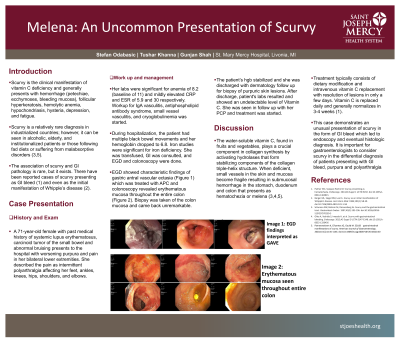Back


Poster Session E - Tuesday Afternoon
Category: GI Bleeding
E0330 - Melena: An Uncommon Presentation of Scurvy
Tuesday, October 25, 2022
3:00 PM – 5:00 PM ET
Location: Crown Ballroom

Has Audio

Stefan Odabasic, MD
Trinity Health Livonia
Livonia, MI
Presenting Author(s)
Stefan Odabasic, MD, Tushar Khanna, MD, Sohaib Hasan Syed, MD, Gunjan Shah, MD
Trinity Health Livonia, Livonia, MI
Introduction: Scurvy is the clinical manifestation of vitamin C deficiency and presents with hemorrhage (petechiae, ecchymoses, bleeding mucosa), follicular hyperkeratosis, hemolytic anemia, hypochondriasis, hysteria, depression, and fatigue. Scurvy is a rare diagnosis in industrialized countries; however, it can be seen in alcoholic, elderly, and institutionalized patients or those following fad diets or suffering from malabsorptive disorders. The association of scurvy and GI pathology is rare, but it exists. There have been reported cases of scurvy presenting as GI bleed and even as the initial manifestation of Whipple’s disease.
Case Description/Methods: A 71-year-old female with past medical history of systemic lupus erythematosus, carcinoid tumor of the small bowel and abnormal bruising presents to the hospital with worsening purpura and intermittent polyarthralgia affecting her feet, ankles, knees, hips, shoulders, and elbows. Labs were significant for anemia of 8.25 and mildly elevated CRP and ESR of 5.9 and 30 respectively. During hospitalization, the patient had multiple black bowel movements and her hemoglobin dropped to 6.8. Iron studies were significant for iron deficiency. She was transfused and underwent EGD and colonoscopy. EGD showed characteristic findings of gastric antral vascular ectasia (Figure 1) which was treated with APC and colonoscopy revealed erythematous mucosa throughout the entire colon (Figure 2). Biopsy of the colon mucosa was unremarkable. The patient was discharged with dermatology follow up for biopsy of purpuric skin lesions. After discharge, patient's labs resulted and showed an undetectable level of Vitamin C. She was seen at follow up by her PCP and treatment was started.
Discussion: The water-soluble vitamin C plays a crucial component in collagen synthesis by activating hydrolases that form stabilizing components of the collagen triple-helix structure. When deficient, small vessels in the skin and mucosa become fragile resulting in submucosal hemorrhage in the stomach, duodenum and colon that presents as hematochezia or melena. Treatment consists of dietary modification and intravenous vitamin C replacement with resolution of lesions in only a few days. Vitamin C is replaced daily and generally normalizes in 3-4 weeks. This case demonstrates an unusual presentation of scurvy in the form of GI bleed. It is important for gastroenterologists to consider scurvy in the differential diagnosis of patients presenting with GI bleed, purpura and polyarthralgia.

Disclosures:
Stefan Odabasic, MD, Tushar Khanna, MD, Sohaib Hasan Syed, MD, Gunjan Shah, MD. E0330 - Melena: An Uncommon Presentation of Scurvy, ACG 2022 Annual Scientific Meeting Abstracts. Charlotte, NC: American College of Gastroenterology.
Trinity Health Livonia, Livonia, MI
Introduction: Scurvy is the clinical manifestation of vitamin C deficiency and presents with hemorrhage (petechiae, ecchymoses, bleeding mucosa), follicular hyperkeratosis, hemolytic anemia, hypochondriasis, hysteria, depression, and fatigue. Scurvy is a rare diagnosis in industrialized countries; however, it can be seen in alcoholic, elderly, and institutionalized patients or those following fad diets or suffering from malabsorptive disorders. The association of scurvy and GI pathology is rare, but it exists. There have been reported cases of scurvy presenting as GI bleed and even as the initial manifestation of Whipple’s disease.
Case Description/Methods: A 71-year-old female with past medical history of systemic lupus erythematosus, carcinoid tumor of the small bowel and abnormal bruising presents to the hospital with worsening purpura and intermittent polyarthralgia affecting her feet, ankles, knees, hips, shoulders, and elbows. Labs were significant for anemia of 8.25 and mildly elevated CRP and ESR of 5.9 and 30 respectively. During hospitalization, the patient had multiple black bowel movements and her hemoglobin dropped to 6.8. Iron studies were significant for iron deficiency. She was transfused and underwent EGD and colonoscopy. EGD showed characteristic findings of gastric antral vascular ectasia (Figure 1) which was treated with APC and colonoscopy revealed erythematous mucosa throughout the entire colon (Figure 2). Biopsy of the colon mucosa was unremarkable. The patient was discharged with dermatology follow up for biopsy of purpuric skin lesions. After discharge, patient's labs resulted and showed an undetectable level of Vitamin C. She was seen at follow up by her PCP and treatment was started.
Discussion: The water-soluble vitamin C plays a crucial component in collagen synthesis by activating hydrolases that form stabilizing components of the collagen triple-helix structure. When deficient, small vessels in the skin and mucosa become fragile resulting in submucosal hemorrhage in the stomach, duodenum and colon that presents as hematochezia or melena. Treatment consists of dietary modification and intravenous vitamin C replacement with resolution of lesions in only a few days. Vitamin C is replaced daily and generally normalizes in 3-4 weeks. This case demonstrates an unusual presentation of scurvy in the form of GI bleed. It is important for gastroenterologists to consider scurvy in the differential diagnosis of patients presenting with GI bleed, purpura and polyarthralgia.

Figure: Figure 1: EGD images of mucosal hemorrhage seen in scurvy
Figure 2: Colonoscopy images of mucosal hemorrhage seen in scurvy
Figure 2: Colonoscopy images of mucosal hemorrhage seen in scurvy
Disclosures:
Stefan Odabasic indicated no relevant financial relationships.
Tushar Khanna indicated no relevant financial relationships.
Sohaib Hasan Syed indicated no relevant financial relationships.
Gunjan Shah indicated no relevant financial relationships.
Stefan Odabasic, MD, Tushar Khanna, MD, Sohaib Hasan Syed, MD, Gunjan Shah, MD. E0330 - Melena: An Uncommon Presentation of Scurvy, ACG 2022 Annual Scientific Meeting Abstracts. Charlotte, NC: American College of Gastroenterology.
